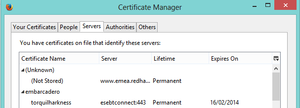Glossary
Go Up to Main Page
Here you can find information about some of the terms that you may run into while you browser the documentation.
A
- Apache Tomcat
- Server technology used by Team Server. More information.
B
- Breadcrumb trail
- A breadcrumb trail is a structured display of resources where the resource to the left is a parent of the resource to the right.


- Business Reports
- This is one of the folders of shared reports distributed with Team Server. See Solution Browser, Business Reports.
C
- Connection Types
- These are the type of connections that people can use to connect to Team Server. Not to be confused with user types. See Overview of User Connections.
- CRUD
- Create, Read, Update, Delete usage relationships.
D
- Diagram
- A graphical presentation of a collection of model elements.
- Digital Certificate
- A digital certificate (also known as a public key certificate or identity certificate) is an electronic document that uses a digital signature to bind a public key with identity information. The certificate can be used to verify that a public key belongs to an individual. You can view installed certificates in Firefox > Options > Advanced Menu.
E
- ETL
- Extraction, Transformation and Load, a process in data warehousing that involves extracting data from other sources, transforming it to fit business need, and then loading it into an end target, such as the data warehouse.
L
- Logical Model
- A logical entity-relationship model conforms to relational theory and contain only fully-normalized entities. For a logical data model to be normalized, it must include the full population of attributes to be implemented and those attributes must be defined in terms of their domains or logical data types.
- A logical data model requires a complete schema of identifiers or candidate keys for unique identification of each occurrence in every entity. The logical model indicates the current identify selection because there are choices of identifiers for many entities.
P
- Pentaho BI Platform
- Architecture and infrastructure to build solutions to business intelligence (BI) problems. Team Server builds its reporting features on top of this platform. More information.
- Permissions
- Gives a user the ability to access the Reporting Repository database. See Overview of User Roles.
- Physical Model
- A complete physical data model includes all the database artifacts required to create relationships between tables and achieve performance goals, such as indexes, constraint definitions, linking tables, partitioned tables, and clusters.
R
- Roles
- Team Server provides default roles. These roles are granted permissions to access actions. The default roles are Authenticated and Super User. See Overview of User Roles.
- Repository
- A database where Team Server stores and maintains data. For Team Server, the database, or repository, is associated with the ER/Studio application.
S
- Security
- All users are authenticated before they are able to run queries and reports. Each user must have a user name and password that is stored in the ER/Studio Repository database.
- Solution
- A set of documents defining the processes and activities required to solve a specific business intelligence problem.
- Solution Repository
- The Solution Repository is the location where solutions and the metadata they rely on is stored and maintained. Requests made to the platform to have actions executed rely on the action being defined in the Solution Repository.
- Scheduler
- Administrative function to schedule an action sequence for execution. See Overview of Scheduling.
T
- Technical Reports
- This is one of the folders of shared reports distributed with Team Server. See Solution Browser, Technical Reports.
